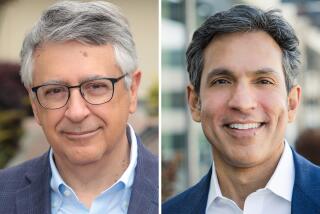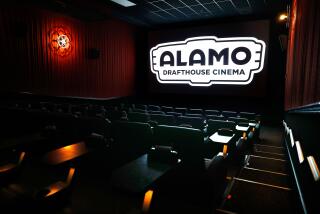Sony Acts as if âGodzillaâ Isnât Scary
The ghosts of âThe Last Action Heroâ are haunting the Culver City studio lot of Sony Pictures right now.
Five years ago, the studioâs former regime was mired in a public relations nightmare when the Arnold Schwarzenegger action comedy failed to live up to the mega-hype lavished upon it in advance of the movieâs debut.
While Sonyâs cast of executive characters has changed since Hollywoodâs infamous summer of 1993 and the studio is arguably a far more congenial, stable place today, thereâs an uncanny parallel in the current managementâs vociferous defense of its much-ballyhooed summer release âGodzilla.â
In both instances, the studio blamed the media.
Only well after the fact did the top executives associated with âLast Action Heroâ concede that they had mishandled the situation by beating their chests shamelessly before their movie opened, then adopting a defensive posture and pointing the finger at the media for a public debacle that was of their own making.
âGodzilla,â unlike âLast Action Heroâ (which grossed $50 million domestically), is not an unmitigated dud. But Sony management is also on the defensive, insisting that the press is âcastigating us unfairlyâ and âbranding the movie a failure,â as one top executive at the studio said of the film, which has grossed just more than $100 million in two weeks of release.
The truth is, âGodzillaâ is neither a flop nor a runaway success.
Sony executives continue to say how proud they are of their âSize Mattersâ marketing campaign--which a number of their competitors agree was impressive, if problematic in that it delivered far more than the film itself. Rivals and critics say the movie simply didnât live up to the sales pitch.
âI think [Sonyâs marketing president] Bob Levin did a brilliant job opening this movie,â said one studio head. âUnfortunately, they over-hyped the movie. It had no emotion, no interpersonal stories and no characters you cared about. . . . The real question is, have we now exhausted this thing called special effects?â
Marketing executives at other companies are stunned that Sony did not test âGodzillaâ with recruited audiences before releasing the film, which is a common practice with virtually all studio movies. Sony sources say the film, which was developed by its TriStar Pictures, was not finished in time to be tested and in retrospect executives privately admit they wish it had been. They also did not see a completed version of the movie until a week before its May 20 release.
What Sony officials wonât say is that they may have over-hyped their movie.
In fairness, if âGodzillaâ had been the runaway success that everyone--the media, the public and Sony management--had expected, no amount of hype would have been considered too much.
Levin may have raised a valid point in a Times interview earlier this week when he said, âAt what point do you move from being a well-marketed movie to the press saying youâve over-hyped the movie?â
But if the press is partly to blame, as Levin suggested, for having âreported on their own expectations,â why isnât Sony willing to concede that âGodzillaâ isnât performing up to the level that it had hoped?
Sid Ganis, who was a top marketing executive at Sony during the âLast Action Heroâ days and is now a producer on the lot, said he commiserated with Levin in a telephone conversation earlier this week.
âI told him, âItâs tough when you have a film with a gigantic profile and you sell it in a gigantic way for it not to become a gigantic target for the press,â â said Ganis, insisting that while he and his colleagues were âdefinitely defensive in the days of âLast Action Hero,â I feel these guys at Sony are not being defensive but appropriate, bold and truthful [in their response to the press].â
At this point, itâs difficult to calculate exactly how much, if any, profit Sony will eventually see from âGodzillaâ once the movie runs through its entire worldwide release cycle. Its production and global marketing costs are believed to be more than $200 million.
Based on its current $104-million box-office take, industry experts expect the film to tap out before hitting $150 million in the U.S. and perhaps as much as double its domestic gross overseas. While Japan is a natural market for âGodzilla,â Sony has to pay Toho Studios--which owns the copyright to the original Godzilla character and has distribution rights to the film in Japan--a hefty distribution fee off the top before it sees dollar one from that territory.
With added revenues from worldwide television sales (NBC bought the domestic broadcast rights for $25 million), video and other sources, industry watchers say âGodzillaâ could make Sony a small profit, but they caution it would hardly be the kind of money the studio had in mind for the movie.
âLast Action Heroâ was also hailed as a franchise maker by studio executives before its release, but those hopes were dashed by the filmâs lackluster reception.
Not so for âGodzilla,â say Sony executives, who insist they have every intention of proceeding with the next two installments in the series as planned.
Before that happens, there will be some intense post-mortem on the film.
Just as Jim Cameronâs mammoth undertaking, âTitanic,â preoccupied Fox for an extended period, âGodzillaâ sucked up a yearâs worth of Sonyâs time, resources and energy--not to mention money--as executives toiled away trying to ensure that the film would be a major event.
About 75 toy, fast-food, video game and T-shirt companies, as well as other corporate partners, signed onto the project. Itâs too early to say whether their bets have paid off.
âGodzillaâ was the catalyst for installing an infrastructure at Sony that would get its various business units working in concert to exploit an event movie beyond the box office and generate revenue for years to come. Despite the theatrical success of a movie like âMen in Black,â Sony has never been able to fully cash in on other business opportunities such as merchandising, interactive games and publishing that such studios as Disney and Warner Bros. have done so well.
Developing franchises has been a top priority of Sony Pictures chief John Calley since he joined the studio two years ago. In fact, his first major piece of business was setting the preexisting âGodzillaâ project into motion and salvaging a deal with Dean Devlin and Roland Emmerich--the creative team behind 1996âs blockbuster âIndependence Day.â
Some Hollywood insiders wonder whether Calley was remiss in allowing Devlin and Emmerich too much creative latitude on âGodzillaâ and in letting them dictate such a key marketing strategy as hiding the physical identity of the reptilian monster until the movie opened.
Calley--who declined to be interviewed--had proclaimed last year, âWhat weâre going to do is a lot more flamboyant, a lot more astonishingâ than anything attempted by âGodzillaâsâ predecessors.
As those affiliated with âLast Action Heroâ can attest, such claims can come back and bite you.
In bragging, size does matter.
More to Read
The biggest entertainment stories
Get our big stories about Hollywood, film, television, music, arts, culture and more right in your inbox as soon as they publish.
You may occasionally receive promotional content from the Los Angeles Times.










